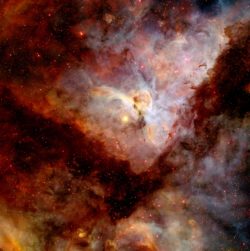Interstellar Chemistry

Carina Nebula - Credit: NASA.gov
The formation of dust around old red giant stars (so-called Asymptotic Giant Branch (AGB stars)) is fundamental for producing a future proto-planetary disk, out which a new solar system can evolve. Indeed, the Earth is composed of stardust that has condensed dust produced by a previous generation star. Our group focuses on how dust forms around oxygen-rich AGB stars. Observations show that this dust is composed of Mg-Fe-silicates. However, these silicates are very difficult to form close to a star where the temperatures are in excess of 1200 K. Thus, it is likely that more refractory materials condense first to form “seeds”, on which the silicates later condense as the outflow from the star cools down. Possible candidates for these seeds include metal titanates (e.g. CaTiO3) and corundum (Al2O3). At Leeds we identify, using electronic structure theory, likely reaction pathways to form these species, and compute reaction rate coefficients using statistical rate theory. These rate coefficients are then used to build up a reaction network in a model of stellar outflow. We will also be starting some laboratory measurements of reactions of species like AlO – which is routinely observed around old stars.
Research and Projects
| Current |
| Laboratory |
|---|
|
| Modelling |
Highlights from the past few years include:
* showed that calcium titanate can form at temperatures around 1500 K in a stellar outflow, making it a potential dust seed (Plane, 2013)
* showed that, although SiO is an abundant species in a stellar outflow, the polymerization of SiO into particles will not occur at temperatures above 700 K (Bromley, 2016)
* published a book chapter on a “bottom-up” approach to modelling particle formation (Bromley and Plane, 2016)
* combined an aerosol microphysics code into a stellar outflow chemistry model in order to study the size evolution of dust in the flow (Gobrecht et al., 2015)
* reported a tentative observation of FeO around an AGB star, using the ALMA telescope in Chile, and explored the severe constraints of forming metal oxides and hydroxides in a stellar outflow where there are high densities of H2 and H (Decin et al., 2018)
Bromley, S. T., Martin, J. C. G., and Plane, J. M. C.: Under what conditions does (SiO)N nucleation occur? A bottom-up kinetic modelling evaluation, Phys. Chem. Chem. Phys., 18, 26913-26922, 2016.
Bromley, S. T., and Plane, J. M. C.: Cosmic and Atmospheric Nanosilicates, in: Computational Modeling of Inorganic Nanomaterials, edited by: Bromley, S. T., and Zwijnenburg, M. A., CRC Press, Boca Raton, 2016.
Decin, L., Danilovich, T., Gobrecht, D., Plane, J. M. C., Richards, A. M. S., Gottlieb, C. A., and Lee, K. L. K.: Constraints on metal oxide and metal hydroxide abundances in the winds of AGB stars - Potential detection of FeO in R Dor, Astrophys. J., 855, article no.: 2, 2018.
Gobrecht, D., Cherchneff, I., Sarangi, A., Plane, J. M. C., and Bromley, S. T.: Dust formation in the oxygen-rich AGB star IK Tau, Astronomy & Astrophysics, 585, article number: A6, 2015.
Plane, J. M. C.: On the nucleation of dust in oxygen-rich stellar outflows, Philosophical Transactions of the Royal Society A, 371, Article Number: 20120335, 2013.
